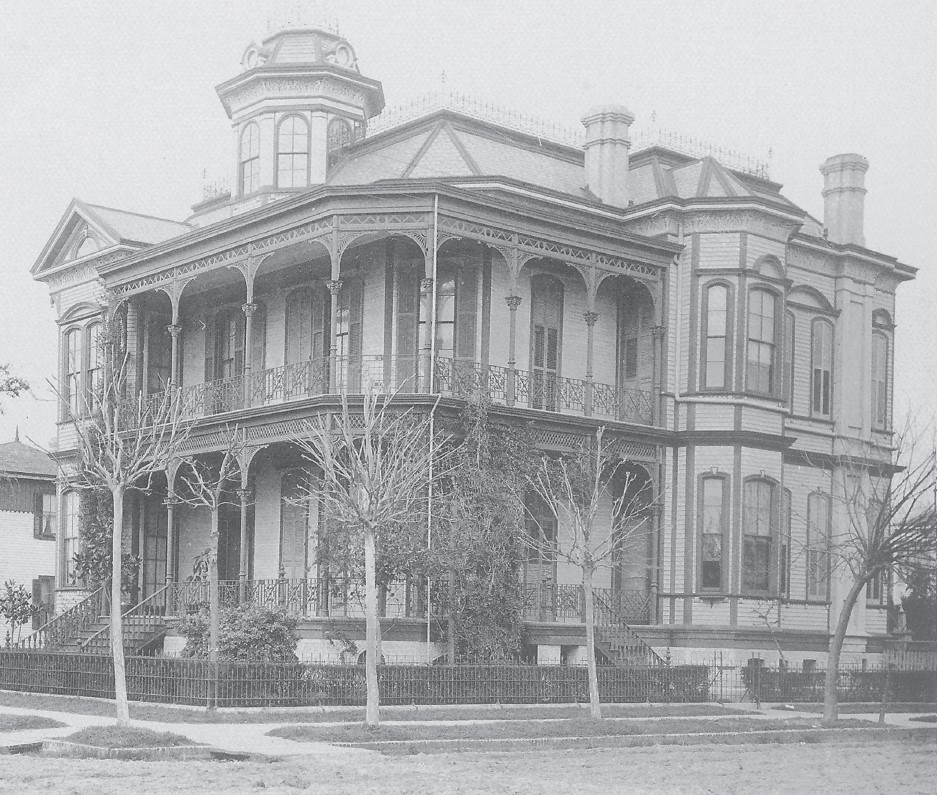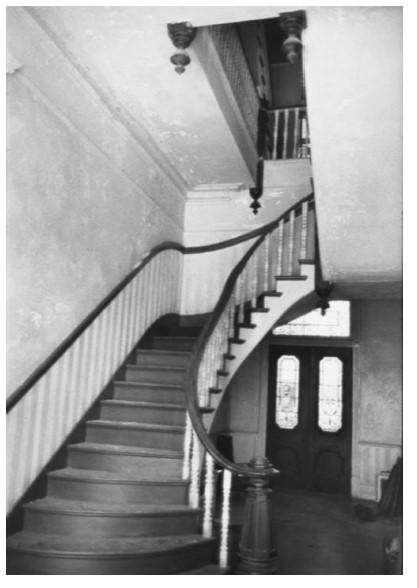 Historic mansions often spark curiosity about the people who lived within their walls. When these architectural treasures are lost, the last traces of families that held important places in Island history are sometimes erased as well. This is the case with the Joseph E. Wallis home that formerly graced the northwest corner of 15th Street and Sealy Avenue.
Historic mansions often spark curiosity about the people who lived within their walls. When these architectural treasures are lost, the last traces of families that held important places in Island history are sometimes erased as well. This is the case with the Joseph E. Wallis home that formerly graced the northwest corner of 15th Street and Sealy Avenue.
Joseph Edmund Wallis (1835-1907) came to Texas with his parents and siblings from Alabama when he was 13, settling in Chappell Hill. His mother Elizabeth Crockett (1795-1866) was a first cousin of the famous frontiersman Davy Crockett, and his father owned a large cotton plantation. After attending Soule University for men in Washington County, Joseph began his own mercantile business and quickly found success.
Wallis married Sarah Catherine “Kate” Landes (1838-1902) in 1860. Less than a year later, the newlywed merchant farmer and his brother John Crockett Wallis (1829-1872) joined the Confederate Army along with many other men from Chappell Hill. They served in numerous battles before returning home to Washington County.
Joseph and Kate’s first son Charles Landes Wallis (1861-1928) was born while his father was away at war. The couple had four more children while living in Chappell Hill: Hood (1864-1865), Hunter (1865-1887), their first daughter Mary (1866-1867), and Daniel (1868-1913). Sadly, Hood and Mary passed away within two years of each other, possibly due to a Yellow Fever epidemic in the area.
Anxious for a new start, Joseph and Kate moved to Galveston with their three remaining sons, along with Joseph’s brother John and his family. Along with Joseph’s brother-in-law Henry A. Landes, the brothers founded Wallis, Landes & Company, Cotton Factors, Wholesale Grocers & Importers on the Strand.
Carrying a stock of groceries, liquors, tobacco, wood and willow wares, and other staples, they were soon transacting over $2.5 million worth of business annually throughout Texas, Louisiana, Arkansas, New Mexico, and Indian Territory.
The first floor of the Wallis-Landes Building with its distinctive windows can still be seen at 2409-2411 Strand; the building lost its top two stories during the hurricane of 1943. Joseph also found success in banking and railroad ventures. The town of Wallis in Austin County founded in 1875 was named in honor of his service on the board of directors of the Gulf, Colorado & Santa Fe Railway Company.
As Joseph and Kate’s wealth grew, so did their family with the addition of daughters Pearl (1871-1959) and Byrd (1874-1893) and son Lockhart (1879-1945). Their large family and status in the community inspired them to build a home to suit their six children and numerous social activities in 1884.

The family erected a stately, two-story cypress mansion on lots 8 and 9 of Block 255, in a one of the island’s choicest residential neighborhoods. There could be no mistake about the identity of the owner of the elaborate house.
A heavy, pewter nameplate on the massive front door was engraved with the name “J. E. Wallis” in elaborate English script. This unique marker remained with the home its entire existence. A carriage step at front walk carried the same inscription.
Upon entering the residence, visitors were greeted with 15-foot ceilings, tall windows, imported stained glass, and exquisite floors of hardwood maple and mahogany. The ornate, carved mahogany and rosewood trim was assembled with hand wrought square nails and pegs, and a bright sitting room at the front of the home and central hall featured plaster ceiling decorations.
The heavily paneled dining room showcased a high, stained beam ceiling and plaster walls adorned with hand painted murals. A butler’s pantry beside the kitchen provided ample storage space for everyday and special occasion serve ware, and food goods were kept in a separate storeroom close to the cooking area.
The focal point of Wallis’ grand ballroom was a beveled Italian mirror that measured 3.5x10 feet and featured a one-foot-wide, hand-carved rosewood frame. A story handed down through the generations of homeowners of the Wallis mansion explains that the mirror was imported from Italy to New York and brought by ox wagon from New York to Galveston.

Another cherished antique that remained in the home through its series of owners was a square, solid-rosewood grand piano once played by Pearl. A marking on the inside of the piano read “re-tuned 1842.”
On the second floor, a hallway connected four bedrooms and two bathrooms. One additional bedroom in the attic was carpeted, but had no bathroom access. The total of ten closets in the original home design was an unusual luxury for the time period.
Four porches surrounded the house where the Wallises and their guests could enjoy Gulf Coast breezes in the summer. In the colder months, they retreated indoors to the comfort of a steam heating system powered by a brick furnace in the basement, in addition to warmth provided by nine fireplaces decorated with imported tile and wooden mantles.
A two-story wood structure behind the main home housed the carriage and stable on the ground floor and servants’ quarters on the second. In later years, the stable was utilized as a garage. Nearby, two wooden cisterns provided water for the property.
The first of many celebrations in the family’s new home was in honor of the 1883 marriage of son Charles to Jonnie Lockhart (1863-1944). Countless formal dinners and balls were hosted there including an annual German Cotillion, a type of dance party that became extremely popular in the years following the Civil War. Referred to as a “German,” the party included games and prizes.
A particularly special German was hosted for 16-year-old Pearl in February 1887. Illustrating why the Wallis home was renowned for its hospitality, a local newspaper reported the event in detail to curious readers the next day, describing the brightly lit rooms, dancing, favors, fanciful costumes, and sumptuous midnight dinner enjoyed by guests. Joseph happily acted as master of ceremonies for all of the activities.
Pearl, a talented pianist who performed at family and community social functions, made her debut in 1890. Two years later, her parents renovated their home in preparation for her wedding festivities.
She married Dr. Robert Knox who would later become president of the Texas State Medical Association and Chief Surgeon for the Southern Pacific Railway. He also helped establish several hospitals in San Antonio, Houston, and Louisiana.
Unfortunately, the Wallis family suffered the deaths of two more of their children in the years they spent on Sealy Avenue, losing 22-year-old son Hunter in 1887 and 19-year-old daughter Byrd in 1893. Her older brother Charles later named his own daughter after her.
 The remaining family survived the 1900 Storm. At the time, Joseph and Kate along with their sons Daniel and Lockhart lived in the house with three live-in servants: a housemaid, coachman, and personal servant. Along with Charles and his family who rode out the storm in their home on Postoffice Street, they were spared the fate of many other Galvestonians.
The remaining family survived the 1900 Storm. At the time, Joseph and Kate along with their sons Daniel and Lockhart lived in the house with three live-in servants: a housemaid, coachman, and personal servant. Along with Charles and his family who rode out the storm in their home on Postoffice Street, they were spared the fate of many other Galvestonians.
On New Year’s Eve 1901, Lockhart married Hettie Major (1879-1959), and they eventually moved to Colorado. Kate passed away the following year, and Charles and Lockhart moved back into the home with their families to care for their ailing father. After Daniel married Frances Edwards (1880-1961) in 1903, Charles moved to Beaumont but continued to run his father’s business affairs.
After a five-year period during which his health significantly declined, Joseph moved to Fort Davis in 1906 to recuperate in a warm climate, leaving Daniel and his wife to look after his home. He apparently improved and visited his son Lockhart in Houston in October 1907. The same week, he went to assist his daughter Pearl move into her new home and suffered a fatal stroke.
Daniel and his wife, who had lived in the Wallis home from the time they married, inherited the mansion and immediately remodeled it by adding electricity and an additional bathroom. The couple continued his parents’ tradition of hosting dances two or three times a year, and their daughter’s 1910 debut was held in the same ballroom that witnessed the event for Daniel’s sisters. He died two days after Christmas in 1913, and his wife remarried and moved to San Antonio.
For the first time since it was built, no member of the Wallis family lived in the home. It was rented to a few different families, and the second floor served as a separate apartment before the house was listed for sale in February 1919. It remained on the market for over a year before Mrs. Ruby D. Smith of Dallas purchased it along with all of its furnishings for $12,000.
 Smith lived in the Wallis home for 37 years before passing away in 1957. She left the house to her niece and namesake, Ruby Davis. Davis and her husband moved to a smaller home next door to the mansion when the upkeep became too much for them.
Smith lived in the Wallis home for 37 years before passing away in 1957. She left the house to her niece and namesake, Ruby Davis. Davis and her husband moved to a smaller home next door to the mansion when the upkeep became too much for them.
At that point, the rosewood piano and extravagant ballroom mirror were sold along with other original furniture. The carriage step was given away as a souvenir to a passing gentleman who admired it.
The magnificent Wallis Mansion was demolished in 1962, and no members of the original family remain on the island.